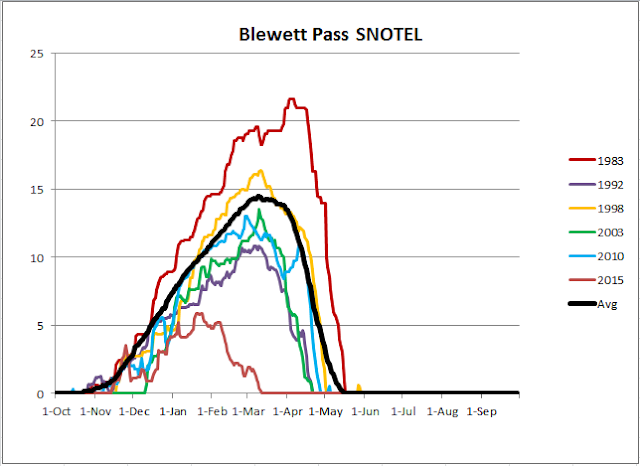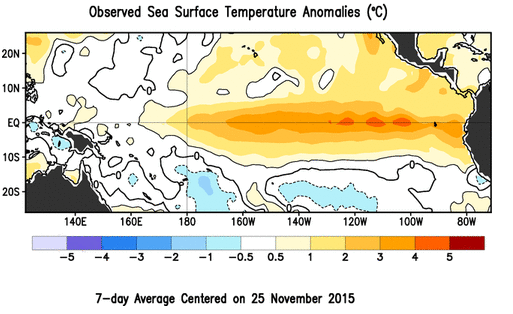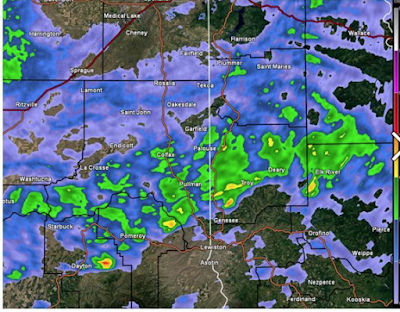Since we wrote up that blog, not much has changed. El Nino continues to be strong. Here's the sea surface temperature anomaly for the past week. This is a classic El Nino signature.
El Nino typically means milder winters in the Pac NW. But after our really mild winter last year, does that mean that this winter will be even milder? In other words, what is a typical El Nino winter like? Let's take a look at some of the recent moderate and strong El Nino winters to see if we can answer that.
2009-10
This was the most recent El Nino winter, and was technically a moderate El Nino, not in the strong category like this winter. But it's still worth a look. Here's some notes from that winter.
- A cold snap in early December dropped daytime temperatures into the teens and sub-zero at night. The month was colder than normal, but the month was rather dry so there wasn't much snow either.
- January was just the opposite. All but a few days were warmer than normal with very little snow.
- February continued the mild trend, but precipitation was near normal.
2002-03
This too was a moderate El Nino.
- December was mild and wet, with rain or snow on just about every day. Temperatures turned a little colder after Christmas resulting in a few inches of low-elevation snow.
- January was also mild and wet. Very few days remained below freezing during the day. And precipitation was twice the normal amount. There were a couple of snowy days.
- February was mild but dry, with little in the way of snow.
1997-98
This is the most recent strong El Nino. So how did it compare to other winters?
- December temperatures were about normal, but it was rather dry. As a result, there were only a handful of snow days. 3.4" fell in Spokane one day, but Moscow had 6" just after Christmas.
- January was similar to December. There was a cold snap in the middle of the month with a couple of sub-zero nights. But most days of the month were in the 30s and 40s. Spokane had about 7 snow "events", each of which amounted to less than 2 inches. Wenatchee Airport had a 13" snow storm in the middle of the month.
- February was more like spring than winter, with day time temperatures in the 40s and 50s, and quite a bit of rain.
1991-92
Another strong El Nino.
- December got the winter off to a mild start. Nearly every day warmed above the freezing mark. As a result, there were only a couple of snow days.
- Temperatures in January were closer to normal with about 6 snow days.
- Aside from a 2-day cool snap, February was very mild and snow free.
1982-83
This strong El Nino is really the first winter when the "El Nino" phrase was used in the general public.
- Winter started early with a couple of cold snaps in November.
- December was typical for the last month of the year. A significant snow storm early in the month was followed by a short cold spell. More snow fell in the middle of the month, and then just before Christmas.
- After a cold snowy start to January, mild weather arrived on the 4th and remained for pretty much the rest of the month.
- The mild weather continued in February, although there were a couple of cold snowy days in the middle of the month.
We could go on, but you probably get the basic idea. El Nino brings milder winters to the Inland Northwest. But there will still be some wintry days, just not as many as normal.
So using the past El Nino winters as an indicator, here's what we can most likely expect this winter:
- December
- Temperatures will probably be normal or just a tad warmer than normal. But it will probably be the coldest month of the winter. Might have a cold episode or two with near zero temperatures at night.
- Expect 3-5 days of snow, but most of these will probably be 1-3". Might see a one day snow storm with more than 3".
- January
- Temperatures will be warmer than December. Sub-freezing day time readings will be rare.
- Might see 2-3 days of snow, probably about 1" each.
- February
- Expect an early spring. Daytime temperatures will be in the 40s and 50s.
- Snow in the lower elevations will be rare.
Remember, last winter had very little snow for the lower elevations. A "normal" El Nino winter will likely have more snow than last winter, but less than a typical winter. So the odds are you'll use your snow shovel/blower more than last winter, but not as much as "usual".
So what is an El Nino winter like in the mountains? Let's take a look at two locations. Bear Mountain in the northern Idaho Panhandle, and Blewett Pass in the Cascades. Here's the graph of Snow Water Equivalent (SWE) for those 2 sites. SWE measures the total amount of water in the snow pack.
 |
| Snow Water Equivalent at Blewett Pass for various years as well as the Average (black line) |
 | |
|
There's a few points to make from these 2 graphs.
- The 1982/83 Strong El Nino actually had an above-normal snow pack in the mountains.
- The other El Nino winters had normal to somewhat below-normal snow pack for the mountains.
- The below-normal snow pack years were still at least 75% of a normal snow pack.
- The snow pack from these El Nino winters melted off sooner than normal, typically by 2-5 weeks.
- All of the El Nino winters had a lot more snow than last winter.
The last of these points is perhaps the most important. The mountain snow pack last year was the lowest ever observed, and melted off sooner than any other winter. Could the upcoming winter see the same? It's possible, but the odds are that we'll see a mountain snow pack that's at least 75% of normal.














